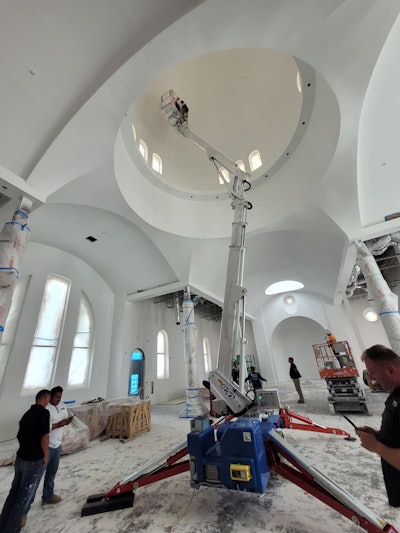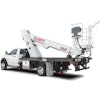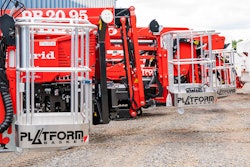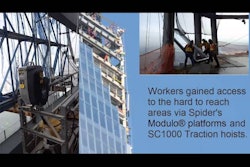
Compact lifts, atrium lifts, compact crawler lifts, spider lifts—no matter what you call them, these types of lifts have been taking up conversation space in the rental segment as of late, despite their relatively smaller size.
"Traditional aerial work platforms were limited by their size, weight and maneuverability, making them less suitable for accessing tight and complex jobsites,” says Tom Schneider, vice president of operations at Tracked Lifts. “Spider lifts, also known as tracked or compact lifts, have emerged as a game-changer in the industry. This evolution has revolutionized the way tasks such as tree care, construction, maintenance and inspection are performed, enabling safer and more efficient operations.”
Compact lift providers describe why these types of lifts have increased in popularity in recent years and explain why they can be a beneficial addition to rental companies’ fleets.
Where it started
Before gaining traction in the U.S., compact lifts first gained popularity in Europe due to their small footprint and accessibility.
“This type of lift became very popular in Europe in the 1980s and 1990s, primarily because they take up less space, and if you look at the old towns in Europe, they have courtyards and narrow streets,” says Ebbe Christensen, president and CEO at Ruthmann Reachmaster North America. “The other side of it was because of the preservation of buildings. A lot of the buildings still had a single door instead of a double door, so you’d need a smaller machine to get through and get inside to renovate or work on atriums.”
The machines started to be seen U.S. in the early 2000s, despite some early hesitation.
“The main problem was that they require more training,” Christensen says. “Unlike with mainstream scissor or boom lifts, with compact lifts, rental companies would have to deliver more training to customers. Plus, we also have more space in our cities here than in Europe.”
However, Christensen notes that after the 9/11 attacks, many buildings required checks on their interior safety systems.
“It was checking things like exit lights, sprinklers or things positioned above stairs that, in the past, would not be checked regularly,” Christensen says.
Additionally, by 2005 and 2006, some rental companies came around to the benefits due to the lifts’ smaller footprint and ability to be used indoors.
“Because they have a track system, they can be used both indoors and outdoors,” Christensen says. “Another big differentiator is that they can go through a single door.”
For areas such as airports, convention centers, museums, train stations, sports arenas and concert venues, that single-door access is key.
Schneider agrees.
“Their ability to navigate through narrow spaces and rough terrains makes them highly versatile and suitable for a wide range of applications,” Schneider says. “Additionally, spider lifts often come equipped with features like nonmarking tracks, compact stowed dimensions and environmentally friendly power sources, enhancing their appeal.”
Christensen adds that many compact lifts are used for maintenance tasks, as opposed to construction jobs.
“The spider lift caters more to the maintenance side, so rental companies can establish a lot of repeat business,” Christensen says. “For example, if someone is washing windows on a building inside or outside, that building will likely have that need at least twice a year. Whereas, with construction jobs, equipment is hot during the construction season, but it goes cold until the next season. With spider lifts, there’s much more repeat business and a much more steady revenue source.”
All of these items combined to make compact lifts a viable addition to rental companies’ fleets.
“Slowly but steadily, the rental companies started to see the value of it, and over the last 10 years, we have seen a big influx of players in the segment,” Christensen says.
What to know
Perhaps one of the most important aspects of rental companies adding compact lefts comes with training.
“Rental companies need to understand that spider lifts require a well-trained staff to both fit the right machine for the customer and to train and support the customer during the rental. The benefits of a spider lift come at a price of a different standard of support,” says Chris Collins, director of sales at Spimerica Access Solutions. “Their increased popularity has come from the acceptance that the higher cost of the spider lifts is well worth the added safety and reliability they bring to the workers and the jobsite. With a correctly trained team, a spider lift offers increased capabilities and safety at every jobsite.”
Rental company staff and customers should also understand that compact lifts can be more fragile than other lifts.
“These lifts are designed to be very lightweight, so you can use these machines where you can’t use others, but the downside is that they’re not as sturdy as boom lifts or scissor lifts,” Christensen says. “So, rental companies need to adjust to the fact that they should do more training, including training about transport.”
In addition to safety and operation training for staff and customers, rental companies should train their staff to understand the many applications in which compact lifts can be used.
“Rental companies should assess the specific needs and requirements of their customer base,” Schneider says. “Understanding the industries and applications where spider lifts are most in demand will help rental companies make informed decisions about which models and configurations to acquire.”
Finally, Schneider notes that it’s crucial to evaluate the maintenance and servicing requirements of these specialized lifts, ensuring the availability of trained technicians and necessary spare parts.
Trends to keep in mind
One significant trend in the compact lift segment is the increasing demand for electric-powered spider lifts, according to Schneider.
“As environmental concerns grow and regulations become stricter, there is a rising preference for eco-friendly equipment,” says Schneider. “Electric spider lifts offer reduced noise levels, zero emissions and improved efficiency, making them an attractive choice for various industries.”
One benefit of the electrification trend, Christensen notes, is that it’s not new to the compact lift market.
“As we see more cities being forced to go electric, that’s not a problem for the compact lift segment because we started with lithium systems long ago,” says Christensen, adding that despite the various benefits of electric systems, it’s crucial that rental companies remind their customers to charge the equipment overnight. “In 2010, we had a machine that had both systems—batteries and a combustion engine. And that became a big deal for rental companies because they could use the batteries indoors.”
Another trend is the integration of advanced technologies in spider lifts, such as remote control capabilities, enhanced safety features and telematics systems for improved fleet management, Schneider says.
Christensen agrees.
“These types of features can help prevent accidents and prevent overloading,” Christensen says.
Also, from a service point of view, it’ll become more normal to see machine diagnostics via internet or phone.
"That will save a lot of money as far as bringing the lift back to the rental store because you can remotely go into the machine and see that it was an operator error," Christensen says.
How to offer them
Because of their versatility, ability to access confined and challenging spaces and ease of use (after training), compact lights are highly sought after, Schneider says.
“That all means quicker setup times and increased productivity on the jobsite, keeping customers happy and potentially bringing them back for more,” Schneider says. “Plus, with their compact size and lightweight construction, transportation costs are reduced, saving rental companies some cash. By diversifying their equipment offerings with spider lifts, rental companies can attract new customers and tap into a wider range of applications. This means more revenue and a bigger slice of the market.”
Rental companies should also be aware that spider lifts can offer boosted profits due to the higher rental rate.
“Spider lifts will offer rental companies more profitability because of the higher rental rate they receive for them and their ability to help complete tough jobs faster than the more traditional way those same jobs were completed,” Collins says.
To let potential customers know that spider lifts are available for rent, Collins recommends that rental companies provide demonstrations to general contractors, property management companies, painting companies and commercial electricians.
Collins says rental companies can also schedule customer events at their facilities to show firsthand the equipment’s capabilities.
Additional ways to educate customers on new compact lift offerings include updating marketing materials, such as websites, brochures and social media platforms; collaborating with industry associations; and engaging in targeted advertising campaigns that can further raise awareness and educate customers about the availability of spider lifts for rental, according to Schneider,
Christensen says that rental companies’ sales staff can also increase compact lift rentals by zeroing in on all the potential work scenarios for compact lifts in their locale.
For example, during training presentations, Christensen encourages rental companies’ sales staff to brainstorm potential applications they may not have initially considered such as swimming pools, churches and factories.
“All of a sudden, the light goes on, and we can generate 20 to 25 leads right there,” Christensen says. “Sales staff needs to understand who their customers are. Just because you buy a spider and put that in your lot, that doesn't mean that the phone will ring.”





















